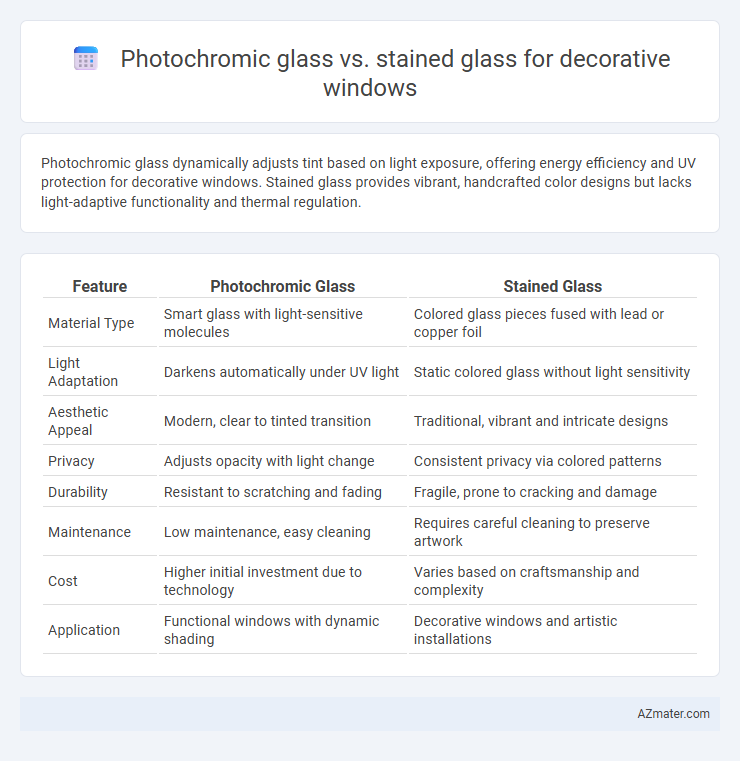Photochromic glass dynamically adjusts tint based on light exposure, offering energy efficiency and UV protection for decorative windows. Stained glass provides vibrant, handcrafted color designs but lacks light-adaptive functionality and thermal regulation.
Table of Comparison
| Feature | Photochromic Glass | Stained Glass |
|---|---|---|
| Material Type | Smart glass with light-sensitive molecules | Colored glass pieces fused with lead or copper foil |
| Light Adaptation | Darkens automatically under UV light | Static colored glass without light sensitivity |
| Aesthetic Appeal | Modern, clear to tinted transition | Traditional, vibrant and intricate designs |
| Privacy | Adjusts opacity with light change | Consistent privacy via colored patterns |
| Durability | Resistant to scratching and fading | Fragile, prone to cracking and damage |
| Maintenance | Low maintenance, easy cleaning | Requires careful cleaning to preserve artwork |
| Cost | Higher initial investment due to technology | Varies based on craftsmanship and complexity |
| Application | Functional windows with dynamic shading | Decorative windows and artistic installations |
Introduction to Decorative Window Glass
Photochromic glass offers dynamic light modulation by darkening in response to sunlight, enhancing energy efficiency and privacy in decorative windows. Stained glass provides intricate, colorful designs by embedding pigments within glass pieces, serving primarily aesthetic and artistic purposes. Choosing between photochromic and stained glass depends on whether functionality or visual artistry is the priority in decorative window applications.
What is Photochromic Glass?
Photochromic glass is a type of smart glass that automatically darkens when exposed to sunlight, providing adaptive shading and reducing glare without compromising visibility. Unlike stained glass, which displays fixed colored patterns created by colored glass pieces or pigments, photochromic glass maintains a clear appearance indoors and responds dynamically to light conditions. This makes photochromic glass ideal for decorative windows that require both aesthetic appeal and functional light control.
What is Stained Glass?
Stained glass is a type of decorative window material created by arranging pieces of colored glass, often painted and then fired to achieve detailed designs and vibrant hues. Unlike photochromic glass, which changes tint in response to light, stained glass provides a constant artistic effect, showcasing intricate patterns and storytelling scenes. Its use dates back to medieval cathedrals, making it a timeless choice for adding both color and historical craftsmanship to interior or exterior windows.
Aesthetic Appeal: Photochromic vs Stained Glass
Photochromic glass offers a modern aesthetic appeal by dynamically changing tint based on light exposure, creating a versatile and sleek look for decorative windows. Stained glass provides timeless beauty with intricate designs and vibrant colors, adding artistic charm and a classic ambiance to interiors. While photochromic glass emphasizes functionality and subtle elegance, stained glass delivers bold visual storytelling through craftsmanship and colorful patterns.
Light Control and Privacy Features
Photochromic glass dynamically adjusts its tint based on sunlight intensity, offering enhanced light control by reducing glare and UV exposure while maintaining visibility, making it ideal for spaces requiring variable light conditions and privacy without obstructing views. Stained glass provides consistent privacy and aesthetic appeal through its colored and textured patterns, diffusing light and obscuring direct visibility but lacking the adaptive light modulation of photochromic glass. Choosing between the two depends on prioritizing either adaptable light control with unobstructed views or permanent decorative privacy.
Durability and Maintenance Comparison
Photochromic glass offers high durability with impact-resistant and UV-protective properties, reducing the need for frequent replacements and maintenance. Stained glass, while visually intricate and artistic, is more prone to cracking and color fading over time, necessitating careful cleaning and occasional restoration. Maintenance of photochromic glass is simpler due to its smooth surface, whereas stained glass requires specialized care to preserve its lead came and painted details.
Energy Efficiency and UV Protection
Photochromic glass automatically adjusts its tint based on light exposure, significantly reducing solar heat gain and enhancing energy efficiency by lowering cooling costs while providing dynamic UV protection. Stained glass, while visually striking, offers minimal thermal insulation and limited UV blocking capabilities, leading to higher energy consumption for climate control. For decorative windows prioritizing energy efficiency and UV protection, photochromic glass delivers superior performance through adaptive light management and durable UV filtering.
Cost Analysis: Which is More Affordable?
Photochromic glass typically costs more upfront due to advanced technology and manufacturing processes, with prices often ranging between $50 to $100 per square foot. Stained glass, while variable in price depending on design complexity and craftsmanship, generally falls between $40 to $90 per square foot, making it potentially more affordable for simpler projects. Long-term, photochromic glass may offer energy savings by reducing heating and cooling costs, potentially offsetting initial expenses.
Best Applications for Each Glass Type
Photochromic glass best suits environments requiring dynamic light control and UV protection, such as modern office buildings and smart homes, where adaptive tinting enhances comfort and energy efficiency. Stained glass excels in creating artistic, colorful focal points in religious institutions, historic restorations, and luxury residences, offering unique aesthetic appeal and cultural significance. Choosing between photochromic and stained glass depends on prioritizing functionality versus decorative artistry in window applications.
Choosing the Right Decorative Glass for Your Windows
Photochromic glass offers dynamic light control by automatically adjusting tint based on sunlight intensity, making it ideal for energy-efficient windows that enhance comfort and privacy. Stained glass provides rich artistic expression with vibrant colors and intricate designs, perfect for adding a timeless, decorative touch and unique character to any space. When choosing the right decorative glass, consider the balance between functionality and aesthetic appeal, where photochromic glass suits modern, adaptive environments and stained glass complements traditional or artistic settings.

Infographic: Photochromic glass vs Stained glass for Decorative window
 azmater.com
azmater.com